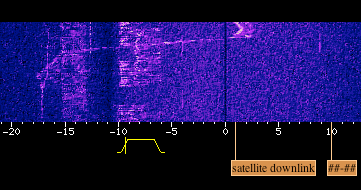Will post a screenshot when I get home.


Also, what could the meandering frequency sweep be? Ionosonde? But over such a limited range (I can't even tell what the range is on this waterfall)
That sweeping signal does not look like an ionosonde of any kind. It looks like voice, and why will be explained below.
I am going to assume the voice mode used for these signals is USB, as that is what the waterfall looks like. I am further going to make another assumption, and this could well be wrong but without knowing which sat you are monitoring it gets tough. My assumption is the sat being monitored is using a Mode B configuration. Mode B simply means you transmit to the sat on 70 cm SSB/CW, and the sat then translates your signal (cross bands or retransmits) to 2 meters SSB/CW. Mode JA would be the other way around, you would transmit up to the sat on 2 meters SSB/CW and listen on 70cm SSB/CW. There are several other modes, with different band and transmit mode (FM/SSB/CW/digital etc) combinations.
Lets take a virtual tour of communicating using the VO-52 satellite in its Mode B inverting operation.
As I said, Mode B is 70 cm SSB/CW uplink, and 2 meter SSB/CW downlink. So you transmit up to the sat on 70 cm, and it retransmits your signal on 2 meters. In this case the sat uses an inverting translator, so you transmit up on 70 cm in LSB and your signal is retransmitted down on 2 meters in USB. The uplink window of operations is 435.220 MHz to 435.280 MHz, or 60 kHz of bandwidth centered on 435.250 MHz. The downlink window is 145.870 MHz to 145.930 MHz, or 60 kHz of bandwidth centered on 145.900 MHz, but inverted.
Think of that bottom waterfall as representing that downlink range, 60 kHz. 0 kHz, or the center of the waterfall, is 145.900 MHz (remember I am just using this as an example, I have no idea what sat is really represented there). So the + numbers are on the high side of that freq, and the numbers on the low side. +25 kHz would be 145.925 MHz, and -25 kHz would be 145.875 MHz.
VO-52 uses an inverting transponder. This means if I send up to the sat on 435.260 MHz LSB, 10 kHz above or + 10 kHz of the center frequency, I will show up on the downlink 10 kHz low, or 10 kHz, of the center freq, at 145.890 kHz, and in USB.
Of course you want to monitor your downlink audio while transmitting, so that you can hear anyone who returns if for no other reason. So, the translation issue can make finding your exact downlink frequency a matter of quick mental jumping jacks (or there are software programs to do it automatically). To top it all off Doppler shift can move frequencies around on you. The satellite is moving fast enough to shift the received and transmitted frequencies noticeably, and as the radial velocity of the sat changes this Doppler shift changes. Sometimes, rather than calculating an ever changing target to hit or if using older equipment, it is just easier to select an empty receive frequency, key the mic, watch the downlink waterfall for your signal to pop up, and then tune your transmit frequency to yield the desired receive frequency.
Ergo
your meandering signal on the waterfall.
T!
(edit) At home now, and I can run the web page (work does not allow it to run). The center of the bottom waterfall appears to be on 144.425 MHz, and I do not know which Hamsat that would be the downlink of.



